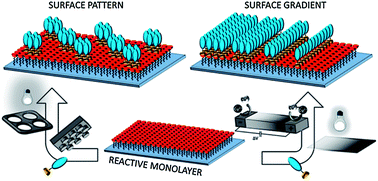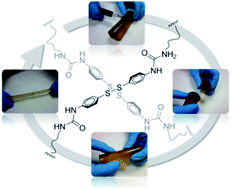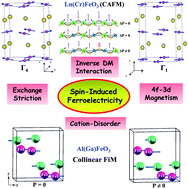Taking Orders from light: progress in photochromic bio-materials
Junji Zhang, Jiaxing Wang and He Tian
 Photochromic materials are a family of compounds which undergo photo-reversible transformations between two different isomers with distinct physical and chemical properties. Most smart photochromic materials have been exploited in research areas such as electro-optical functional materials, while recently their applications have extended to novel bio-materials. Biological systems, such as tissue/cellular imaging, nucleotides, peptides, ion channels, etc., have emerged as a revolutionary research frontier for photochromic materials since both covalent coupling and non-covalent interactions with bio-molecules have been achieved. This review commences with a brief description of exciting progress in this field, and describes strategies for using photochromic functional molecules from bio-sensing and cell imaging to optical manipulation of bio-macromolecules (nucleotides, peptides, ion channels, GFP, etc.). Further development of these photo-switches as well as remaining challenges are also discussed and put in prospect.
Photochromic materials are a family of compounds which undergo photo-reversible transformations between two different isomers with distinct physical and chemical properties. Most smart photochromic materials have been exploited in research areas such as electro-optical functional materials, while recently their applications have extended to novel bio-materials. Biological systems, such as tissue/cellular imaging, nucleotides, peptides, ion channels, etc., have emerged as a revolutionary research frontier for photochromic materials since both covalent coupling and non-covalent interactions with bio-molecules have been achieved. This review commences with a brief description of exciting progress in this field, and describes strategies for using photochromic functional molecules from bio-sensing and cell imaging to optical manipulation of bio-macromolecules (nucleotides, peptides, ion channels, GFP, etc.). Further development of these photo-switches as well as remaining challenges are also discussed and put in prospect.
Mater. Horiz., 2014, DOI: 10.1039/c3mh00031a, Advance Article
Reactive self-assembled monolayers: from surface functionalization to gradient formation
Carlo Nicosia and Jurriaan Huskens
 This review describes the progress of the development of surface chemical reactions for the modification of self-assembled monolayers (SAMs) and the fabrication of surface chemical gradients. Various chemical reactions can be carried out on SAMs to introduce new functionalities. “Click” reactions, which are highly efficient and selective, have largely contributed to the development and implementation of surface chemical reactions in the fields of biotechnology, drug discovery, materials science, polymer synthesis, and surface science. Besides full homogeneous functionalization, SAMs can be modified to exhibit a gradual variation of physicochemical properties in space. Surface-confined chemical reactions can be used for the fabrication of surface chemical gradients making the preparation of exceptionally versatile interfaces accessible.
This review describes the progress of the development of surface chemical reactions for the modification of self-assembled monolayers (SAMs) and the fabrication of surface chemical gradients. Various chemical reactions can be carried out on SAMs to introduce new functionalities. “Click” reactions, which are highly efficient and selective, have largely contributed to the development and implementation of surface chemical reactions in the fields of biotechnology, drug discovery, materials science, polymer synthesis, and surface science. Besides full homogeneous functionalization, SAMs can be modified to exhibit a gradual variation of physicochemical properties in space. Surface-confined chemical reactions can be used for the fabrication of surface chemical gradients making the preparation of exceptionally versatile interfaces accessible.
Mater. Horiz., 2014, DOI: 10.1039/c3mh00046j, Advance Article
Catalyst-free room temperature self-healing elastomers based on aromatic disulfide metathesis
Alaitz Rekondo, Roberto Martin, Alaitz Ruiz de Luzuriaga, Germán Cabañero, Hans J. Grande and Ibon Odriozola
 Aromatic disulfide metathesis has been reported as one of the very few dynamic covalent chemistries undergone at room-temperature. Here, bis(4-aminophenyl) disulfide is effectively used as a dynamic crosslinker for the design of self-healing poly(urea–urethane) elastomers, which show quantitative healing efficiency at room-temperature, without the need for any catalyst or external intervention.
Aromatic disulfide metathesis has been reported as one of the very few dynamic covalent chemistries undergone at room-temperature. Here, bis(4-aminophenyl) disulfide is effectively used as a dynamic crosslinker for the design of self-healing poly(urea–urethane) elastomers, which show quantitative healing efficiency at room-temperature, without the need for any catalyst or external intervention.
Mater. Horiz., 2014, DOI: 10.1039/c3mh00061c, Advance Article
Novel features of multiferroic and magnetoelectric ferrites and chromites exhibiting magnetically driven ferroelectricity
Rana Saha, A. Sundaresan and C. N. R. Rao
 A few oxides such as YMnO3, TbMnO3, YMn2O5 and BiFeO3 constituted the small family of well-characterized multiferroics until recently, but this area of research has been enlarged significantly due to the advent of a novel class of oxides exhibiting interesting multiferroic and magnetoelectric properties arising from magnetically induced ferroelectricity. Interestingly, these materials are simple transition metal oxides, most of them possessing the perovskite structure. In this review article, we present the significant features of multiferroic and magnetoelectric ferrites and chromites which owe their ferroelectricity to magnetic interactions. Some of the important systems discussed are BiFeO3 whose properties are affected by magnetic and electric fields, rare-earth orthoferrites LnFeO3 (Ln = Dy, Gd and Sm) and rare-earth orthochromites LnCrO3, where exchange-striction plays a significant role. Perovskite oxides of the type Y(A1−xBx)O3 (A, B = Fe, Cr, Mn) exhibit multiferroic properties, although the existence of these properties in YFeO3 and YCrO3 is in doubt. Such oxides with a non-magnetic rare-earth cation at the A site and two transition metal ions in the B-site permit tuning the transition temperatures by varying the B site ions and their relative proportions or the Ln ion. Multiferroic properties of simple ferrites such as Al(Ga)FeO3 where cation disorder appears to play a role are also discussed. Problems and challenges in this area of research are indicated.
A few oxides such as YMnO3, TbMnO3, YMn2O5 and BiFeO3 constituted the small family of well-characterized multiferroics until recently, but this area of research has been enlarged significantly due to the advent of a novel class of oxides exhibiting interesting multiferroic and magnetoelectric properties arising from magnetically induced ferroelectricity. Interestingly, these materials are simple transition metal oxides, most of them possessing the perovskite structure. In this review article, we present the significant features of multiferroic and magnetoelectric ferrites and chromites which owe their ferroelectricity to magnetic interactions. Some of the important systems discussed are BiFeO3 whose properties are affected by magnetic and electric fields, rare-earth orthoferrites LnFeO3 (Ln = Dy, Gd and Sm) and rare-earth orthochromites LnCrO3, where exchange-striction plays a significant role. Perovskite oxides of the type Y(A1−xBx)O3 (A, B = Fe, Cr, Mn) exhibit multiferroic properties, although the existence of these properties in YFeO3 and YCrO3 is in doubt. Such oxides with a non-magnetic rare-earth cation at the A site and two transition metal ions in the B-site permit tuning the transition temperatures by varying the B site ions and their relative proportions or the Ln ion. Multiferroic properties of simple ferrites such as Al(Ga)FeO3 where cation disorder appears to play a role are also discussed. Problems and challenges in this area of research are indicated.
Mater. Horiz., 2014, DOI: 10.1039/c3mh00073g, Advance Article
All articles published in Materials Horizons benefit from wide exposure, with free access upon registration to all content published during 2014 and 2015
Follow the latest journal news on Twitter @MaterHoriz or go to our Facebook page.














